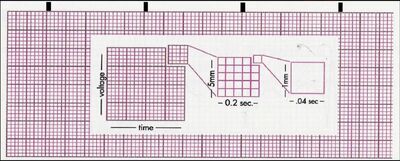Electrocardiography (ECG or EKG) is a transthoracic interpretation of the electrical activity of the heart over time captured and externally recorded by skin electrodes. It is a noninvasive recording produced by an electrocardiographic device. The etymology of the word is derived from electro, because it is related to electrical activity, cardio, Greek for heart, graph, a Greek root meaning "to write".
Electrical impulses in the heart originate in the sinoatrial node and travel through the intrinsic conducting system to the heart muscle.The impulses stimulate the myocardial muscle fibres to contract and thus induce systole. The electrical waves can be measured at selectively placed electrodes (electrical contacts) on the skin. Electrodes on different sides of the heart measure the activity of different parts of the heart muscle. An ECG displays the voltage between pairs of these electrodes, and the muscle activity that they measure, from different directions, also understood as vectors. This display indicates the overall rhythm of the heart and weaknesses in different parts of the heart muscle. It is the best way to measure and diagnose abnormal rhythms of the heart, particularly abnormal rhythms caused by damage to the conductive tissue that carries electrical signals, or abnormal rhythms caused by levels of dissolved salts (electrolytes), such as potassium, that are too high or low. In myocardial infarction (MI), the ECG can identify damaged heart muscle. But it can only identify damage to muscle in certain areas, so it can't rule out damage in other areas. The ECG cannot reliably measure the pumping ability of the heart; for which ultrasound-based (echocardiography) or nuclear medicine tests are used.
Problem Solving[]
Leads[]

Proper placement of the limb electrodes, color coded as recommended by the American Health Association.
An ECG monitor acquires the respiration wave and rate from lead 2. A ECGs most common problem during preventive maintenance is bad leads. These leads should be inspected or replaced as required by the manufacturers recommendation intervals E.g. On a routine PM inspection, we use an ECG simulator to measure the beats per minute on each lead. The leads are:
- RA - Right Arm - white
- LA - Left Arm - black
- LL - Left Leg - red
- RL - Right Leg - green
- V1 - V6 (chest leads) - brown
A wandering baseline, noise, or artifacts are normally caused by a patients movement of electrode on the skin.
Paper Speed[]

One second of ECG graph paper
Timed interpretation of an ECG was once incumbent to a stylus and paper speed. Computational Analysis now allows considerable study of Heart Rate Variability. A typical electrocardiograph runs at a paper speed of 25 mm/s, although faster paper speeds are occasionally used. Each small block of ECG paper is 1 mm². At a paper speed of 25 mm/s, one small block of ECG paper translates into 0.04 s (or 40 ms). Five small blocks make up 1 large block, which translates into 0.20 s (or 200 ms). Hence, 5 large blocks equals 1 second. A diagnostic quality 12 lead ECG is calibrated at 10 mm/mV, so 1 mm translates into 0.1 mV. A calibration signal should be included with every record. A standard signal of 1 mV must move the stylus vertically 1 cm, that is two large squares on ECG paper.
Here are two common problem solving scenarios:

Standard ECG paper strip
1. The patient’s heart rate is 120 beats per minute. Your start recording their waveform in the ECG and decide to print out the results for the cardiologist to see. A paper speed of 25mm/sec is set on an ECG recorder. In a normal ECG waveform, the "R" wave show up as two and a half (2.5cm) big boxes on the ECG paper.
2. Using your test equipment you feed a 1 millivolt signal into ECG leads. The monitor is set to read on lead 2. Also, you are using only a 3 lead ECG set. The monitor ECG size is set and you are reading 1 millivolt signal on the screen. Next, you run a strip on the paper recorder. The result is 2 vertical squares on the printed paper indicating that the 1 millivolt response is correctly working.
Performance Checks[]
- Batteries
- Leads
- Knobs
- 1 millivolt step response
- Date and Time
- Display brightness
- Paper
- Speeds
- Recorder
- Chassis